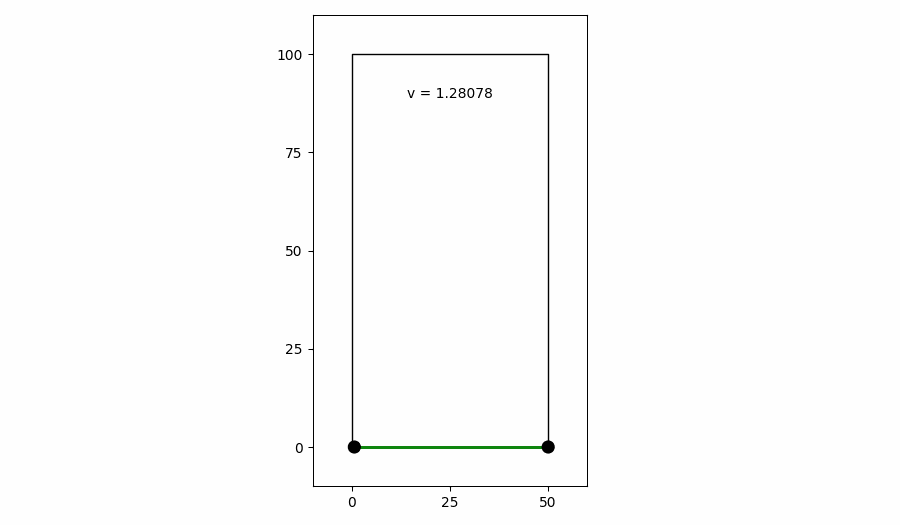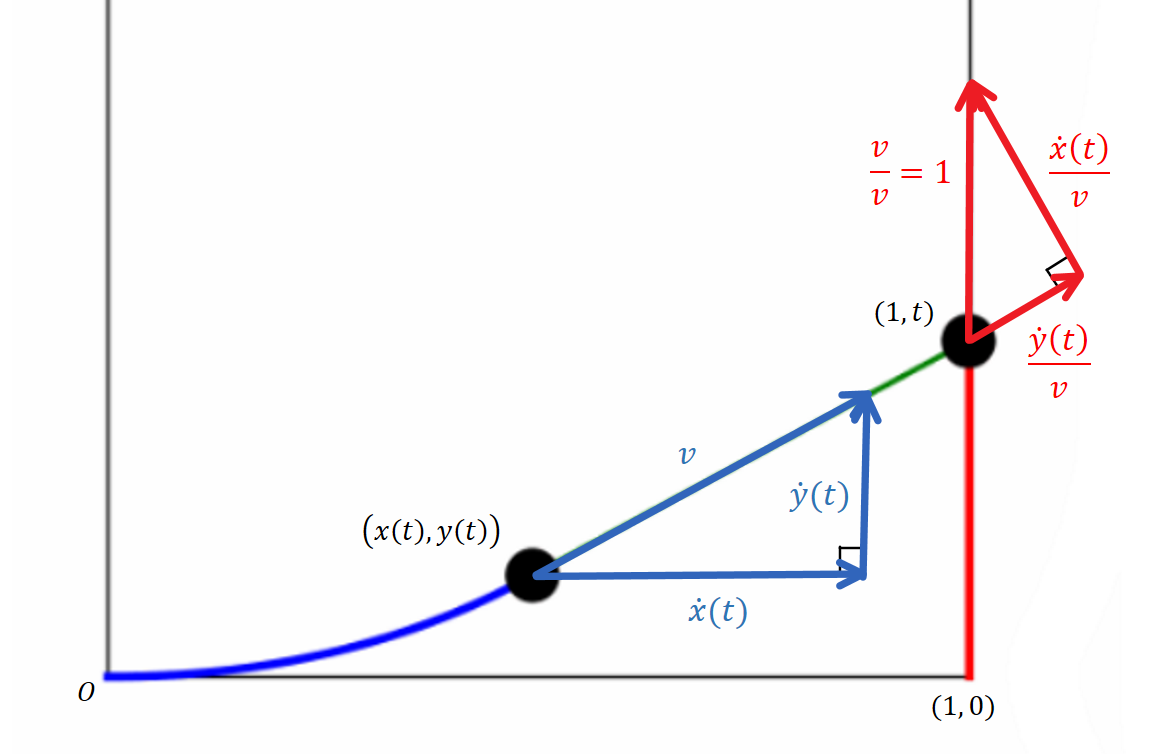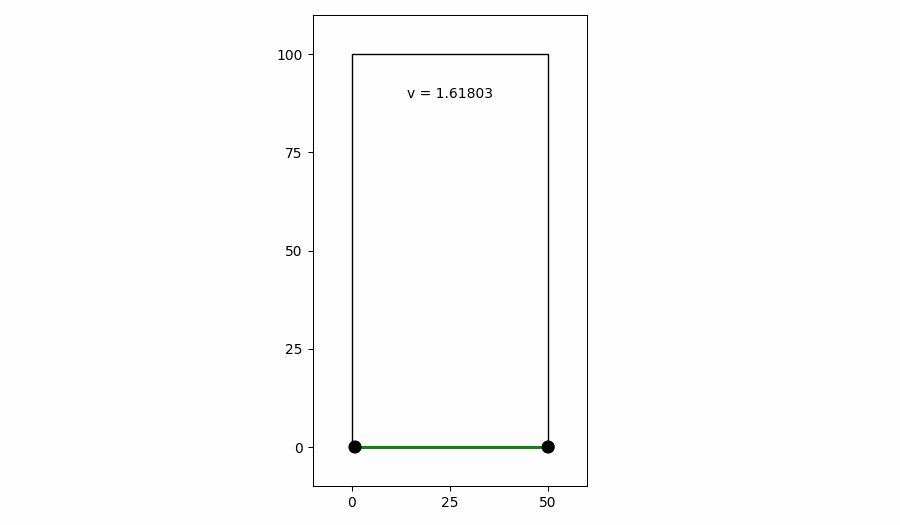Radiodrome prodrome (27/08/21 Riddler Classic)
If the field length is twice the goal line length, the chaser must run $\dfrac{1+\sqrt{17}}{4}\approx 1.28078$ times as fast as the target.

The blue curve is the result of a chaser travelling at constant speed and always directly towards the instantaneous position of the target. The name for such a curve is the radiodrome or pursuit curve.
For simplicity, we select units such that the length of the field is $1$ and the length is $2$. Actually, let's keep it general; suppose the interception happens at some y-coordinate $L$.
Let the chaser's position be $(x(t),y(t))$ with $(x(0),y(0))=(0,0)$. The target's position is $(1,t)$. This means the target moves at speed $1$ while the chaser moves at $v$.
Here are two methods to solve for $v$ such that $(x(L),y(L))=(1,L)$, indicating the interception occurs at $t=L$.
Method #1: Calculus-free approach
We first consider the chaser's vertical motion. We know the chaser, travelling vertically at speed $\dot{y}(t)$, must travel a total of $L$ in the vertical direction within the time period $t\in[0,L]$. This fact is a surprise tool that will help us later.
Now, consider $g(t)$ which is the length of the green line. Notice that $g(0)=1$ but $g(L)=0$, meaning that over $t\in[0,L]$, the line has on net contracted by $1$. This contraction is the result of the chaser's and target's movements:
-
The chaser always travels directly towards the target, so the chaser contributes a constant speed $v$ towards $g(t)$'s contraction. Over the period $t\in[0,L]$, this results in a total shrinkage of $\color{blue}{\boxed{vL}}$.
-
However, the target elongates $g(t)$ instead. Although the target travels at a constant velocity $1$ in the vertical direction, only the component in the direction parallel to $g(t)$ actually contributes to elongating $g(t)$. (The instantaneous perpendicular motion serves only to rotate, but not elongate, the green line.)
We exploit some geometric similarity to show that the target's motion parallel to the green line occurs with velocity $\dfrac{\dot{y}(t)}{v}$ (see Fig. 2).
Recall now our surprise tool, which is that an object moving at $\dot{y}(t)$ travels a total distance of $L$ over the period $t\in[0,L]$. The target's parallel speed is $\dfrac{\dot{y}(t)}{v}$ over $t\in[0,L]$, so its total elongation length must thus be $\color{red}{\boxed{\dfrac{L}{v}}}$.

And so, $g(t)$'s net contraction of $1$ must be the chaser's contraction $\color{blue}vL$ minus the target's elongation $\color{red}\dfrac{L}{v}$:
$$\begin{align*}\therefore 1 &= vL - \frac{L}{v}\\\therefore 0&=v^2L-v-L\\\therefore v &= \color{red}{\boxed{\frac{1+\sqrt{1+4L^2}}{2L}}}\end{align*}$$
noting that we ignore the other root as that will result in a negative $v$.
For a sanity check, we can express this equation also as $$v=\frac{1}{2}\Big(\frac{1}{L}+\sqrt{\frac{1}{L^2}+1}\Big)$$which clearly monotonically increases as $L$ decreases. This confirms our intuition that the faster the chaser runs, the sooner they'll intercept the target.
With our actual problem where $L=2$, we have the aforementioned solution that $$\color{red}{\boxed{v=\frac{1+\sqrt{17}}{4}\approx 1.28078}}$$
Method #2: Solving for the radiodrome exactly
We can also arrive at our answer by first finding the expression $y(x)$ that describes the radiodrome curve.
As mentioned before, the slope of the green line, which is also the tangent of the radiodrome (blue line), is $$\frac{dy}{dx}=y'=\frac{t-y}{1-x}$$
Multiplying both sides by $(1-x)$ and taking the derivative wrt. $x$:
$$\begin{align*}y'&=\frac{t-y}{1-x}\\y'(1-x)&=t-y\\\therefore y''(1-x)-y'&=\frac{dt}{dx}-y'\\\therefore y''\cdot\dot{x}(t)&=\frac{1}{1-x}\end{align*}$$
We can deduce $\dot{x}(t)$ given that the tangent line has slope $\dfrac{t-y}{1-x}$:
$$\begin{align*}\dot{x}(t)&=v\cdot\frac{1-x}{\sqrt{(1-x)^2+(t-y)^2}}\\&=v\cdot\frac{1}{\sqrt{1+(\frac{t-y}{1-x})^2}}\\&=\frac{v}{\sqrt{1+y'^2}}\end{align*}$$
Substituting this into the above equation, we obtain a differential equation that is purely geometric (ie. time-independent): $$\frac{y''}{\sqrt{1+y'^2}}=\frac{1}{v(1-x)}$$
The LHS is simply $\frac{d}{dx}\sinh^{-1}(y')$. Hence we integrate both sides wrt. $x$: $$\sinh^{-1}(y')=-\frac{1}{v}\ln(1-x)+C_1$$
To determine the constant $C_1$, we use the initial condition $y'=0$ when $x=0$, indicating that the chaser's initial movement is purely horizontal. Substituting $y'=0, x=0$ into the above yields $C_1=0$. Manipulating the above further:
$$\begin{align*}\sinh^{-1}(y')&=-\frac{1}{v}\ln(1-x)\\\therefore y'&=\sinh\Big(-\frac{1}{v}\ln(1-x)\Big)\\&=\frac{1}{2}\Big(\exp\big(-\frac{1}{v}\ln(1-x)\big)-\exp\big(\frac{1}{v}\ln(1-x)\big)\Big)\\&=\frac{1}{2}\Big((1-x)^{-1/v}-(1-x)^{1/v}\Big)\\\therefore y&=\frac{1}{2}\int \Big((1-x)^{-1/v}-(1-x)^{1/v}\Big)dx\\&=-\frac{1}{2}\Big(\frac{(1-x)^{1-1/v}}{1-1/v}-\frac{(1-x)^{1+1/v}}{1+1/v}\Big)+C_2\end{align*}$$
To determine the constant $C_2$, we use the other boundary condition, which is that the interception occurs at $(1,L)$. Substituting $x=1, y=L$ into the above yields $C_2=L$. Now, to determine the value of $v$, we can use our initial condition of $(0,0)$ again by substituting $x=0,y=0$ into the above equation:
$$\begin{align*}0 &= L - \frac{1}{2}\Big(\frac{1}{1-1/v}-\frac{1}{1+1/v}\Big)\\&=L-\frac{1}{2}\Big(\frac{v}{v-1}-\frac{v}{v+1}\Big)\\&=L-\frac{v}{v^2-1}\\\therefore 0 &= v^2L-v-L\\\therefore v&=\frac{1+\sqrt{1+4L^2}}{2L}\end{align*}$$
which is the same expression for $v$ as in Method #1.
Having kept the solution general means we have some fun numbers showing up. For instance, if the field is square and $L=1$, we have $v=\frac{1+\sqrt{5}}{2}$, highlighting yet again how the golden ratio appears at the most surprising times.
